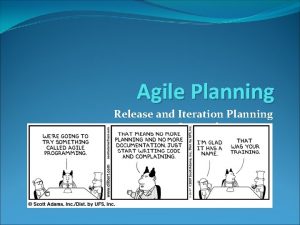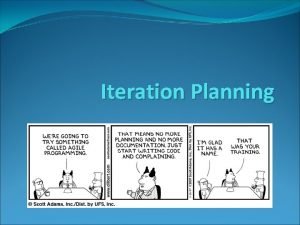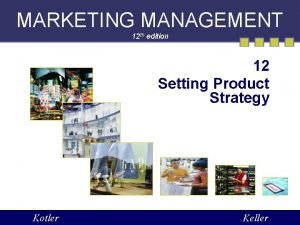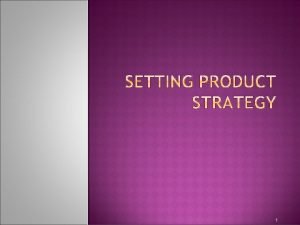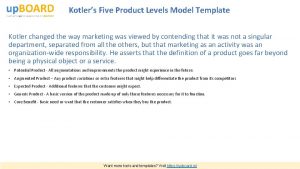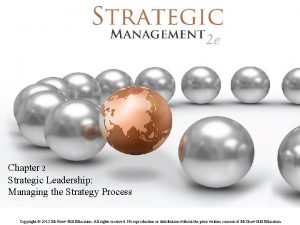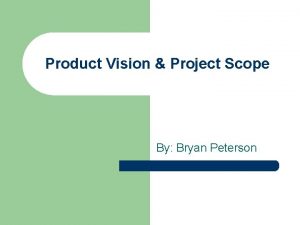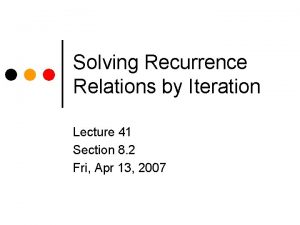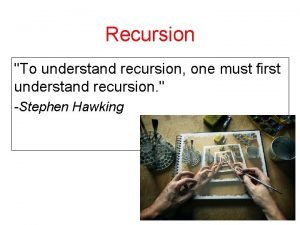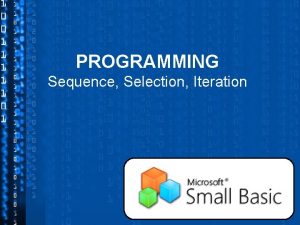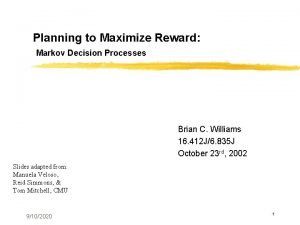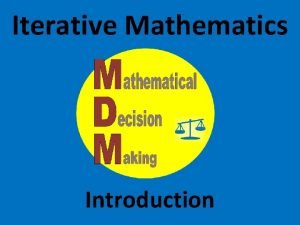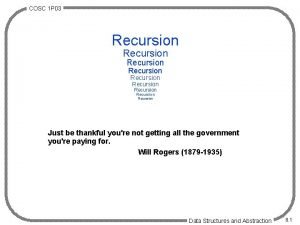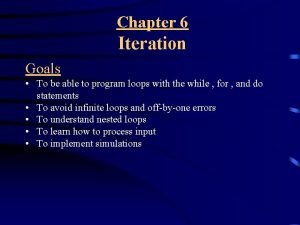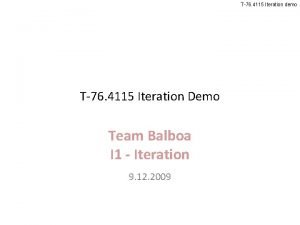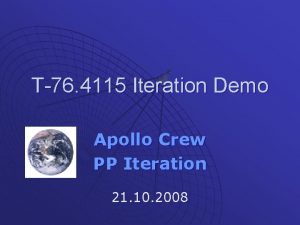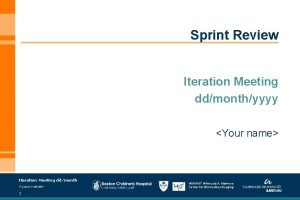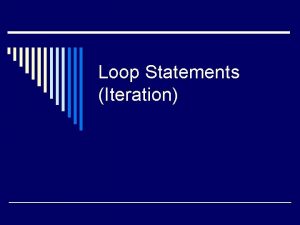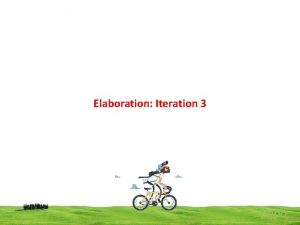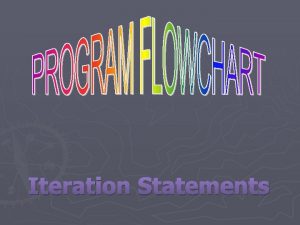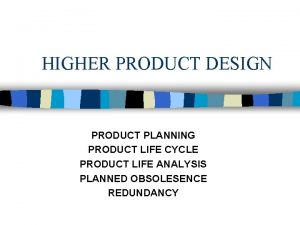Iteration Planning 5 Levels of Planning Product Vision































- Slides: 31

Iteration Planning

5 Levels of Planning Product Vision Product Roadmap Release Plan Iteration Plan Daily Standup Adapted from “ 5 Levels of Agile Planning” by Hubert Smits

Iteration Planning �Define scope as a team �Define a clear understanding of “done” �Plan just enough that you can commit

Roles �Product Owner �Scrum Master �Team Member

Product Owner �Prioritizes the backlog �Communicates what is important … and what is not �Is a proxy for the customer and other stakeholders

Scrum Master �Responsible for the process �Facilitates the meeting

Team Member �Asks questions �Collaborates with others �Signs up for work

The Backlog �A ranked list of stories �What is a story? �A scenario that we must do work to implement which results in business value �Typically in the form of: “As a <type of user>, I want <feature> so that <business value>” �Good stories meet the INVEST criteria

Before you Start � Well Groomed Product Backlog � Prioritized � Estimated � Iteration Theme/Goal Estimated Prioritized

Exercise 1 �Create a prioritized backlog �As a <user> I want <feature> so that <business value> �Estimate relative size �At least enough for one iteration �Choose any domain you like �We’ll use the results in a future exercise What’s your goal for the iteration?

A Typical Iteration Planning Session � Discuss Logistics � Review Iteration Goals � Understand the Stories � Task Out the Stories � Commit Typical Duration: 3 -4 hours Attendees: • Product owner • Scrum master • Delivery team Materials: • Stories (cards or online) • Task planning material (cards, whiteboard, online) • Planning/estimation materials (e. g. planning poker cards)

Discuss Logistics �Review Historical Velocity �Review Team Availability �Holidays / Vacations �Meetings �L 3 Support, outside commitment, etc �Review the Definition of Done

Definition of Done �You need to define for your environment �Definition will evolve over time �Example: �Unit tests written and passed �Acceptance tests automated and passed �User facing documentation written �Checked in to the build �No defects introduced

Review Iteration Goal(s) �Product Owner �Explain the Goal (theme) �Make priority adjustments based on feedback from delivery team �Team Members �ASK QUESTIONS �Understand the Goal, not just the desired features

Understand the Story �Product Owner �Explain the Story �Explain the “Why” (“as a <role> I <what> so that <WHY>”) �Break down as needed �Elaborate on acceptance criteria/tests �Make priority adjustments based on feedback from team �Team Members �Understand the story �Understand question the acceptance criteria (how will you build a test for each? What about…) �Validate the size/implementability

Acceptance Criteria �What is required for the success of this story? �Typically determined at iteration planning jointly between product owner, dev, QA, writers, etc.

Task out the Story �Define tasks �Estimate the work involved �Validate capacity again The Product Owner can help in avoiding less valuable work

Hold Off On Names �Keeps everyone focused on all the tasks, not just theirs �Encourages team commitment �Within the iteration, encourages focus on priorities �And teamwork

Repeat �Until the team cannot take on more �Split stories as necessary

Splitting a Story �The closer to the present a story is, the smaller it will become �Those for this iteration need to fit within the iteration �When splitting a story, each “slice” should add incremental user value

Commit �Everyone agrees the iteration is doable �Use disagreement and uneasiness in team members to drive out hidden risks, tasks, and issues �Drive agreement with a fist of five � Absolutely, no question � I think this is good and will make it happen � I can support this � I’m uneasy about this and think we need to talk about it more � Let’s continue discussing this idea in the parking lot

Effective Meetings �Everyone should be focused on the task at hand �No working on laptops �Every minute should be valuable �If not, figure out how to make it so

Tools

Exercise 2 �Do iteration planning �Go through stories in priority order �Create acceptance criteria �Task out �Stop when you can’t do more �Commit Do you believe in your result?

Estimating �Identify a medium sized story that is well understood; call it a 5 �Now estimate other stories relative to that �Is it about the same, ½ as difficult, twice as difficult? �Use Fibonacci numbers: 1, 2, 3, 5, 8, 13, 21 �If bigger than that or if too hard to estimate, split the story �Tackle as a team; Planning poker can help (www. planningpoker. com)

Why Story Points? �Time estimates �Vary by person �Encourage padding �Tend to grow stale �Story points �More consistent from person to person �Not a commitment to time frame �Don’t change as much �Easier to estimate relative size

Velocity �Now that stories have sizes, you can track how many points you typically get done in an iteration �You can now use this to predict future completion rates

Release Planning Deliverables �Plan for each Iteration �Assumptions �Dependencies �Risks �Are things synched up across teams? �Are you attacking the most important stories? �Does the team believe in the results?

Coordinating Teams �Simplest if one team has the skills to take on an item by themselves �If not, try to minimize the gap �Within the same iteration is ideal �Touch base before and after iteration planning �Daily scrum of scrum meetings can help

Kanban �Instead of planning it all up front, you can pull things in as you go �Keep iterations (Scrumban) or not (pure Kanban) �Advantages �More flexibility (great for start ups and support) �Disadvantages �Less predictability �Harder to coordinate

Questions? Walter Bodwell Planigle wbodwell@planigle. com Twitter: @wbodwell www. planigle. com www. walterbodwell. com
 Which statement defines the purpose of iteration planning?
Which statement defines the purpose of iteration planning? What is meant by an iteration goal
What is meant by an iteration goal Levels of thinking
Levels of thinking Human vision vs computer vision
Human vision vs computer vision 5 product levels
5 product levels 5 levels of customer value hierarchy
5 levels of customer value hierarchy Five product levels
Five product levels Developing a product vision
Developing a product vision Product oriented vision statements provide managers with
Product oriented vision statements provide managers with Product vision and project scope
Product vision and project scope Newton raphson method
Newton raphson method 4115
4115 Recurrence relation solver
Recurrence relation solver Recursion vs iteration
Recursion vs iteration What is sequence selection iteration programming
What is sequence selection iteration programming Value iteration
Value iteration Value iteration
Value iteration Orthogonal iteration
Orthogonal iteration Value iteration algorithm
Value iteration algorithm Value iteration
Value iteration What is the purpose of an iteration recap
What is the purpose of an iteration recap Iterative rule for sequence
Iterative rule for sequence What is iteration in computer science
What is iteration in computer science Recursion
Recursion Iteration definition computer science
Iteration definition computer science Avle chapter 6
Avle chapter 6 Successive approximation method in numerical methods
Successive approximation method in numerical methods Iteration variable
Iteration variable Final iteration definition
Final iteration definition Similarities between iteration and recursion
Similarities between iteration and recursion Value iteration
Value iteration Value iteration
Value iteration
